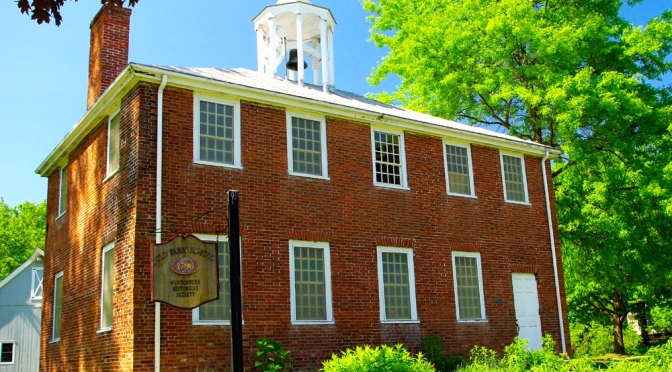|
Can you answer these Trivia Questions about Bloomfield?
1. What was the name of the concert series held on the Connecticut General lawn?
2. What famous general was entertained at Wintonbury’s Butterball Tavern in 1824?
3. What product was the first made in the U.S. by William Barton in Wintonbury about 1770?
4. What Old St. Andrews Rector was jailed for royalist sympathies?
5. When was the first Sacred Heart Church built?
THE OLD FARM SCHOOL
The Old Farm District was a section of Wintonbury that had been originally settled. On or near the site of the Old Farm School at the corner of School Street and Park Avenue stood an old log-house that was used for community activities. (In 1839, this log building was sold for $3.43.) The following ad appeared in the Connecticut Courant in May 1796:
“The subscribers wish to contract for the building of a brick school in Wintonbury 35 by 22 feet. Any person wishing to contract to furnish materials and complete the building is desired to call on, the subscribers before the 30th of May who will pay them money for the work.
S. Eggleston
G. Latimore
J. Loomis
Wintonbury, April 20, 1796”
By the end of that year, Wintonbury had a handsome, symmetrical two story brick school with the entrance in the center of the building and a fireplace on each end. This may have been a Christopher Wren design; plans from his collection could be purchased. Known as the Brick School until 1839, it was one of the five planned for the parish in 1795. The second story was not used or even finished until 1829 when it was voted to finish it for older “scholars.” At that time access to the second floor was by way of an outside staircase; inside stairs were built in 1843. One can see on the outside wall where the original doorway to the second floor was bricked over.
Frederic Bull who lived on Blue Hills Avenue contributed the school bell that was rung to announce public functions, church services and funerals. Ironically the first funeral for which it rang was Mr. Bull’s.
Miss Hannah Latimer was the first teacher. The wood for the fireplaces was contributed by the students’ families, each with a quota of about 3/8 of a cord. Scholars sat on benches facing the center of the room, boys on one side, girls on the other.
In 1809 it was voted that each scholar bring in 3 ft. of wood, delivered within one week after the beginning of the school year or the “child shall be debarred of the common use of the fire.” In 1815, one fireplace was eliminated when a brick stove was installed. It was paid for in 1819 by computing the number of days each family sent children to school. The assessment was about 6 mills per scholar per day.
When the Blue Hills School on Rockwell Avenue was completed in 1922, the Old Farm School was closed. The building continued to be used for community activities – meetings, neighborhood gatherings, and as a library. The American Legion and its Auxiliary met there from 1931 to 1971.
The original site of the Old Farm School was in the middle of a triangle of land that had been deeded to be used forever for use of the community. When the State wanted to relocate School Street to create a safer intersection with Park Avenue, arrangements were made to exchange this triangle for land across the street. The Wintonbury Historical Society raised money to repair, move and restore the old school.
Under the direction of the late architect and then- president of the Wintonbury Historical Society, Richard Bartlett, the school was moved 100 feet to its new location in October 1976 but it wasn’t until 1987 that the first floor was restored and opened to the public. It was placed on the Register of Historic Places in 1979.
The Old Farm School is open to the public Sunday afternoons from mid-May until mid-September.
by Ralph Schmoll
Wintonbury Historical Society |

